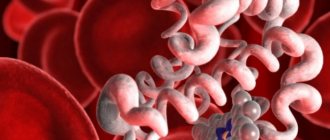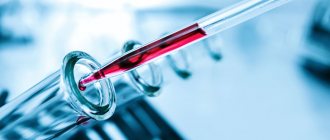Regardless of whether you are planning to have a baby or not, a missed period always causes worry for women. And the first thing to do in this case is to determine whether conception has occurred, namely, take pregnancy tests. The most common and accessible method is home rapid tests. But, as practice shows, the results are often inaccurate. In order not to make an endless number of attempts, doctors recommend resorting to a more reliable method - taking a blood test for pregnancy, the result of which will discard all further doubts.
What kind of research is this? What does it show? How to determine pregnancy using a blood test? When and how to take it? Let's figure it out.
What is a pregnancy blood test called?
Laboratory blood tests to determine conception reveal a special hormone in a woman’s body - human chorionic gonadotropin (hCG). It is produced by the membrane of the embryo - the chorion, and begins to be released into the body from the first hours of fertilization of the cell. And if this hormone is present in the body, there is conception. Moreover, its concentration in the blood of a pregnant woman doubles every two days. And its level reaches its highest value at 8-11 weeks, after which there is a decrease.
Express pregnancy tests also determine the level of hCG, showing that second line, but the concentration of this hormone in the urine is much lower and increases at a much slower rate. Therefore, a more accurate test for determining fertilization is considered to be a blood test, which can detect conception already 2-5 days after fertilization. While test strips are given only after a week.
Did you know? The concentration of hCG levels in blood serum is significantly higher than in urine, almost 2 times.
For the normal development of the fetus, the level of this hormone in a woman is very important, because it also indicates the success of the growth and development of the fetus, therefore it is necessary to monitor it throughout the entire period of bearing a child.
Hormone growth and timing of conception
Many patients know that pregnancy can be determined by the growth of human chorionic gonadotropin. Tables are used for this purpose. In different laboratories, data may differ by several units. General figures are for the first trimester.
From the moment the blastocyst is fixed, the hormone begins to actively increase. The numbers are doubling every day. These facts help clarify the timing of home testing. Considering that most tests have a sensitivity of 25 units, they can be used from the first day of the expected delay.
This fact can be explained simply. The female reproductive cell goes through a certain path from ovulation to conception. After the cell is removed from the follicular sac, it enters the abdominal cavity. The egg remains in the peritoneum for no more than eight hours. The contractile function of smooth muscle influences the localization of the egg. It gradually moves into the cavity of the fallopian tube. The fusion of the egg with the male sperm occurs in the tube. From this moment the zygote begins its journey into the uterine cavity. The average travel time is 5 days. It takes 1 day to fix. From the sixth day, chorion appears between the endometrium and the cyst. Doubling the hormone leads to 30 units on the 9th day after the development of the chorion. This day is the second day of the menstrual cycle delay. Testing can be done on this day.
Based on the amount of human chorionic gonadotropin, you can easily determine the approximate day of conception. Doctors also examine the course of gestation and fetal development.
What exactly does it show?
Also, the hCG hormone helps predict the duration of pregnancy, based on the level of its concentration in the blood.
It is very important to monitor its level throughout the entire period of waiting for the child, as it can indicate possible pathologies in the development of the fetus. The first screening is done between the 11th and 14th weeks of pregnancy, where the plasma protein PAPP-A is also examined and an ultrasound of the embryo is performed, which determines the presence of chromosomal abnormalities in the fetus. Repeated studies, the second screening, are carried out at 16-20 weeks. The data obtained is not a final diagnosis, and only determines the risk group and prescribes additional studies. It should also be noted that determining the level of hCG is only part of the study, which in itself is not a reliable screening.
Deviations from the norm can appear with such serious problems as a missed or ectopic pregnancy, threat of failure (in the early stages), pathologies in fetal development, multiple births, etc.
Important! In non-pregnant women, a high level of hCG may indicate a number of cancer diseases (tumors of the mammary glands, ovaries, gastrointestinal tract, etc.).
How else can such an analysis be useful?
A woman takes a UAC every month while expecting a baby. It allows you to assess the course of pregnancy and the health of the mother not only by the level of hemoglobin, red blood cells, or the number of leukocytes. Its task is also to determine allergies in pregnant women. Basophils are responsible for its detection. During allergies (or rhinitis during pregnancy, which many mothers experience), their number increases. The growth of basophils can be triggered by allergies to dust, animal dander and vitamins.
Another indicator indicating the development of an allergic reaction is the number of eosinophils.
Blood neutrophils indicate the development of a bacterial infection in the body, the occurrence of purulent processes, for example, sore throat, otitis media, meningitis.
Lymphocytes in the blood of pregnant women indicate a decrease in the level of immunity. While carrying a baby, the expectant mother's body is subjected to a heavy load, causing a weakening of the immune system, which is reflected in a blood test.
The number of monocytes is important. These are large leukocytes, the number of which increases if the expectant mother has a cold, an acute respiratory viral infection, influenza, or mononucleosis, which can be determined by enlarged lymph nodes.
Important details on this topic can be found in the video:
When can I get tested and what is the procedure like?
A blood test for hCG levels can already be taken if your period is delayed by 3-5 days. If the exact date of conception is known, within a week you can go to the laboratory to confirm or deny the fact of conception. Be prepared to repeat the procedure at least twice after 2 days, preferably at the same time and in the same laboratory, to monitor growth dynamics.
The test is taken in the morning on an empty stomach by drawing blood from a vein. If you take it during the day, then the day before it is recommended to abstain from food for 4-6 hours. If you are taking hormonal medications, you must notify your doctor. It is also recommended to exclude heavy physical activity, nervous shock and physiotherapeutic procedures the day before visiting the laboratory.
Ultrasound monitoring (folliculometry)
This study makes it possible to determine how the dominant follicle develops, how tall the endometrium is, and to determine at what time ovulation occurs. For ovulation to occur, the dominant follicle must reach 20 - 22 mm, and the thickness of the endometrium must be 10 - 12 mm. Ultrasound monitoring is carried out several times per cycle, the timing depends on the duration of the menstrual cycle. If a woman’s cycle lasts 28 days, then the first study should be carried out on days 6–8 of the cycle.
Decoding results during pregnancy
The first thing you should pay attention to when interpreting laboratory test results is the units of measurement. They can be as follows - honey/ml, unit/lm, mIU/ml, mIU/ml. There is no need to specifically translate one into the other, they are one and the same, and there is an equal sign between them. But priority attention should be paid to the readings of the norm, since each laboratory will have its own. This depends on the sensitivity of the methods used.
You also need to know that in case of multiple pregnancy, the hCG level will increase by a multiple of the number of embryos. The level of this hormone increases rapidly every 7 days until the 10th week, after which it stabilizes for a while and begins to gradually decrease until the moment of birth.
Tables of hCG norms by week , widely distributed on the Internet, clearly demonstrate such dynamics.
In the 1st-2nd week, the hormone level is low and averages from 50 to 300 mU/ml. Over the next 7 weeks, it continues to grow rapidly, reaching its peak at the 7-8th week, when the upper limit of normal is 200,000 mU/ml. And during the next two trimesters of waiting for the baby, there is a gradual decrease to 10,000 - 60,000 mU/ml at the time of birth. In this case, to determine the period, the date of the last menstruation is taken, and not the date of conception.
Did you know? The hCG hormone is also present in the male body, stimulating the production of sex hormones and sperm. Its level is about 2 mU/ml.
Remember - only your attending physician can give the most reliable interpretation of the data. Because the normal range is quite wide and a number of individual factors must be taken into account. And some indicator for one woman may be a suspicion of pathological processes, but for another it is completely within the normal range. Therefore, only a doctor who knows all the features of your body can draw conclusions and prescribe next steps.
Deviation from the norm: what is dangerous and what to do?
During laboratory testing, there are two possible deviations from the norm - hCG is higher and lower than normal.
A low level of this hormone in a blood test for pregnancy in the early stages indicates quite dangerous and pathological conditions:
- hormonal imbalance in a woman;
- ectopic pregnancy;
- intrauterine fetal death;
- risk of miscarriage;
- pathologies in embryo development.
In the later stages, this may be evidence of post-term pregnancy. In any case, the real cause is determined by the doctor, based on additional research.
An elevated hCG level can occur with:
- multiple pregnancy;
- taking hormonal medications;
- diabetes in a woman;
- toxicosis;
- gestosis;
- pathologies of embryo development.
When receiving the results, you should not draw hasty conclusions. Deviations from the norm in any direction can often be caused by incorrect determination of the gestational age. And only the doctor makes a decision on further actions. And the first thing he prescribes is a repeat test, because it is very important to monitor the level of this hormone over time. Also, for further conclusions, additional diagnostics are carried out, the basis of which is ultrasound.
Conducting and transcribing the study
The material is submitted for research in the morning. It is recommended to give up breakfast, drinking alcohol, smoking, tea or coffee. The last meal should be in the evening, no later than 20-21 hours. To get tested, you must contact the laboratory, saying the name of the study. How long will it take for the result to be ready and whether it can be obtained urgently depends on the laboratory in which it is carried out.
You can get tested in any city, be it Krivoy Rog or St. Petersburg, in a private laboratory. No one will forbid you to go to the laboratories of a public clinic. But there are often long queues in public clinics, so it is important not to miss the deadline for the test indicated in the referral by the obstetrician-gynecologist who is observing the woman.
The cost of the test depends on the level of the laboratory and the speed of the result. In any case, its price is not high relative to its great information content and importance.
The results of the hCG test are interpreted using special tables that indicate the normal level of hormones by week of pregnancy. This table shows whether conception has occurred if the test is carried out in the early stages, and also whether the fetus has developmental pathologies if the test is carried out in the 2-3 trimester.
Could the analysis be wrong?
Like any test, hCG testing carries a risk of errors. Such results are called false negative (if conception occurred, but the analysis did not reveal this) and false positive (fertilization did not occur, but the analysis shows the opposite). The likelihood of the former increases if you donate blood too early, when the fertilized egg has not yet attached to the wall of the uterus and the hormone level is too low. The cause may also be late ovulation, ectopic pregnancy, or a sharp change in hormonal levels. False-positive results can occur when taking hormonal drugs that include hCG, as well as in cases of serious tumor diseases.
Although very rare (with a probability of less than 2%), erroneous analysis data are obtained when the procedure for collecting material in the laboratory was violated, or there was an error in determining the gestational age.
In any case, if you have any doubts, consult your gynecologist and undergo a number of necessary additional studies.
How to understand that you are pregnant early?
Certain symptoms, how to find out if you are pregnant in the early stages without a test, indicate the presence of a fetus.
You can determine whether conception has occurred at the very beginning based on the following signs:
- presence of discharge in small quantities;
- feeling of nausea;
- changes regarding diet;
- blood pressure is reduced;
- sensitivity to odors.
Symptoms of how to understand that you are pregnant in the first days without a test boil down to general fatigue and possible discomfort in the uterine area. The most obvious symptom is the appearance of a small amount of discharge. Occurs at the beginning of the first trimester. They are distinguished by their scarcity, yellowish or pinkish tint. The presence of discharge is explained by the fact that the egg is attached to the walls of the uterus.
Nausea occurs in the first weeks. Many people don’t pay attention to this at first. Certain smells begin to irritate you, and unusual food preferences appear, for example, something salty. Is it possible to eat ginger during early pregnancy?
Signs of how to find out that you are pregnant without a test at home include:
- temperature increase;
- breast enlargement;
- You may feel discomfort in the lower abdomen.
You can determine the presence of a fetus by paying attention to the temperature, which often rises above 37 degrees in the first weeks. It also provokes some lethargy in the girl.
Conception often provokes a feeling of discomfort in the lower abdomen. There is a feeling of heaviness and a strange tingling sensation. This is due to the egg, which attaches to the wall of the uterus. After which it gradually increases. All this helps to determine at home without a test whether a woman is pregnant.
One of the symptoms of how to find out if you are pregnant without a test at home is intestinal dysfunction. The presence of a fetus may be indicated by an increased urge to go to the toilet. This sign will accompany all trimesters. Subsequently, the fetus will begin to put pressure on the genitourinary system, which will provoke frequent urination.
The main signs of pregnancy
When the question arises, “how can I find out if I’m pregnant at home without a test?”, it is recommended to monitor bowel function. Pregnancy is often accompanied by bloating, severe gas, and constipation.
Hormonal changes indirectly affect the functioning of the intestines, which become lazy. It is possible to determine that there is a pregnancy if at least several of these signs are present. If you need to know how to understand that you are not pregnant without a test, you should take the above measures.
There is no pregnancy when:
- temperature indicators are within normal limits, do not change - there is no increase or decrease, regardless of whether ovulation has occurred or not;
- when conducting a urine test, it began to bubble, which indicates the absence of a fetus;
- There are no universal, key symptoms of fertilization, including nausea, sudden mood swings, changes in the chest area.
Other diagnostic methods
The simplest and most familiar home rapid tests operate on the same principle, only they detect the level of hCG in the urine, where its concentration is much lower. The modern rapid test is sufficiently sensitive and most often gives reliable results about the presence of conception. In addition, its accessibility and ease of use are an undeniable advantage. It is with its help that most women get rid of doubts, and a blood test only finally confirms the result. Therefore, these two methods complement each other perfectly.
But ultrasound provides the greatest accuracy in determining conception. Already from the 4th week of pregnancy, the intravaginal sensor visualizes a fertilized egg measuring about 2 mm. And later (from the 5-6th week) it makes it possible to confirm the formation of the yolk sac, the attachment of the embryo into the uterine cavity and the viability of the fetus. Taken together, the level of hCG and ultrasound make it possible to identify all possible pathologies in the early stages.
In some cases, it is also recommended to be tested for another hormone - progesterone. It not only shows the presence of fertilization, but is also an important indicator of the successful preservation and growth of the embryo.











